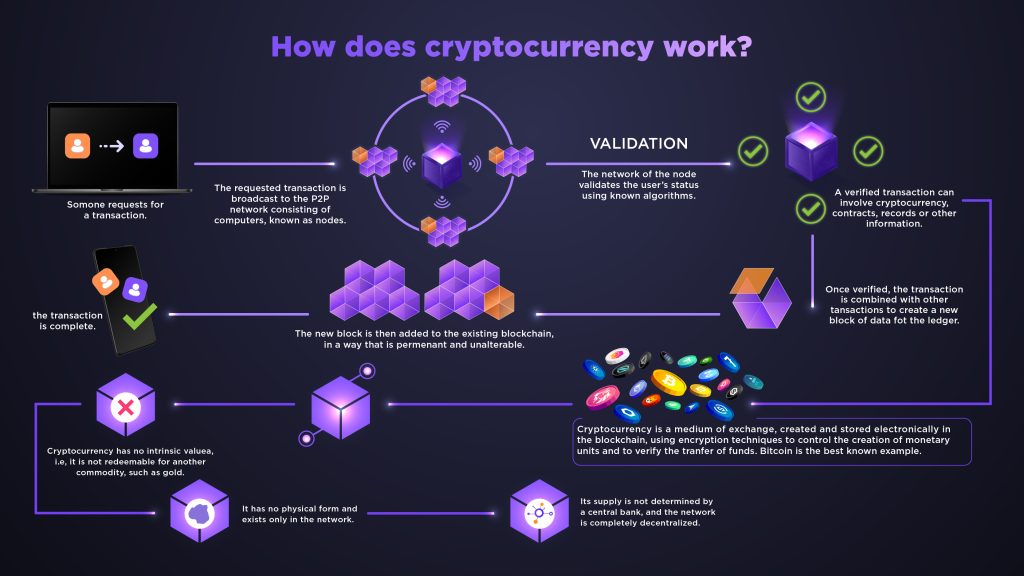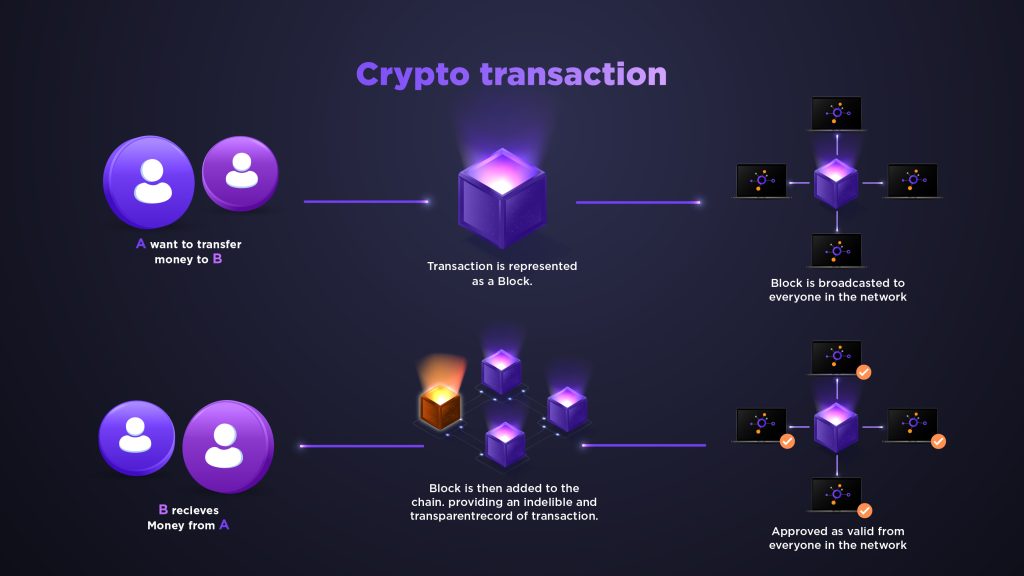The Beginner who want to enter the world of cryptocurrency should read this article as it will provide a comprehensive understanding of the subject. The article covers various aspects of cryptocurrency, including crypto definition, its advantages, how does cryptocurrency work, and much more. By reading this article, individuals will gain a deeper understanding of the world of cryptocurrency and be better equipped to navigate it.
What is cryptocurrency?
Cryptocurrency is a digital or virtual currency that uses cryptography for security. Cryptography is the practice of secure communication, which is often used to protect online transactions. The most important feature of it is that it is not controlled by any central authority: the decentralized nature of blockchain makes it theoretically immune to the old ways of government control and interference.
Transactions are recorded on a public ledger called a blockchain, and each has its own blockchain. In order to make transactions on a blockchain, an individual must have a digital wallet with a unique address, which serves as a destination for sending and receiving the currency.
Unlike traditional currency, its value is determined by supply and demand on the open market, and it can fluctuate widely in a short period of time. One of the first and most well-known is Bitcoin, it was created in 2009 and it is decentralized, open-source, and uses peer-to-peer technology, allowing for online payments without the need for an intermediary. Since the release of Bitcoin, thousands of others have been created, known as altcoins, and many of these have similar features and use cases to Bitcoin, but with various differences such as faster transaction speeds or increased privacy.
It can be exchanged for other currencies, products, and services. Some companies accept Bitcoin and others as payment for goods and services, and it can also be bought and sold on cryptocurrency exchanges, where people can buy and sell using fiat currency or other it.
Advantages of Cryptocurrency
There are several benefits of using cryptocurrency, including:
- Decentralization: It operates independently of a central bank, which means that it is not controlled by any government or financial institution. This decentralization can provide increased security and stability as it reduces the risk of a single point of failure.
- Security: transactions are recorded on a public ledger called a blockchain, which is extremely difficult to alter or tamper with. This means that transactions are secure and can’t be changed once they’ve been recorded on the blockchain.
- Transparency: The blockchain is a public ledger, which means that all transactions are visible to anyone. This can increase transparency and accountability in financial transactions.
- Anonymity: transactions do not require the use of personal information, which means that users can remain anonymous. This can provide increased privacy and security for individuals and businesses.
- Fast and low-cost transactions: transactions can be processed quickly and at a lower cost than traditional transactions. This can make it particularly useful for small transactions, micropayments, and cross-border transactions.
- Accessibility: cryptocurrency can be accessible to anyone with an internet connection, which means that it has the potential to provide financial services to individuals who are unbanked or underbanked.
- Innovation potential: blockchain technology is still relatively new and has a lot of room for development and innovation. This allows for various new use cases to be developed, such as decentralized finance (DeFi) or non-fungible tokens (NFTs).
How does cryptocurrency work?

Cryptocurrency uses blockchain technology to record and verify transactions. A blockchain is a decentralized digital ledger that records transactions across a network of computers.
When someone wants to make a transaction, such as sending Bitcoin to another person, the transaction is broadcasted to the network.
Nodes, which are computers running the cryptocurrency software, then work to verify the transaction and ensure that the person making the transaction has enough of it to complete it.
Once the transaction is verified, it is grouped with other verified transactions into a block. This block is then added to the existing chain of blocks, creating a permanent and unchangeable record of all the transactions that have taken place on the network.
One of its key features is that it is decentralized and operates independently of a central bank. This means that transactions are not processed by a central authority and no one entity has control over the currency. Instead, transactions are processed by a network of users.
In order to use it, a user needs a digital wallet, which is a software program that allows them to store, send, and receive currency. Each wallet has a unique public address and a private key, which are used to access and authorize transactions. The public address is like a bank account number, and it is used to receive the currency, while the private key is like a password that is used to authorize transactions and access the wallet.
Another important aspect of it is the process of mining, which is the process by which new units of it are created and added to the existing blockchain. Miners use powerful computers to solve complex mathematical equations and are rewarded with new units of it for their efforts. This process ensures the integrity of the blockchain and prevents fraud and double-spending.
How does crypto transaction work?

- A user initiates a transaction to transfer bitcoin to B
- The transaction is packaged as a block, including details such as the sender, receiver, and amount of bitcoin involved.
- The block is broadcast to all participants in the bitcoin network.
- The transaction is validated by other participants in the network to ensure its validity.
- Once the block is confirmed as valid, it is added to the existing chain of blocks, forming a publicly available, permanent record of the transaction.
- B receives the transferred bitcoin from A.
Is crypto real money?
The question of whether or not it is real money is a topic of debate among experts. Some argue that it is a legitimate form of currency, while others believe that it falls short of meeting the criteria of what constitutes money.
One of the main arguments in favor of it being considered real money is that it can be used as a medium of exchange, just like traditional fiat currencies. Additionally, it can be traded on cryptocurrency exchanges and its value can fluctuate based on supply and demand.
Another argument in favor of it being considered real money is that it offers many of the same benefits as traditional money, such as greater security and privacy. The decentralized and cryptographic nature of its transactions makes them difficult to hack or counterfeit, and personal information is not typically required for transactions.
However, there are also several arguments against it being considered real money. One of the main criticisms is that the value of many is highly volatile, which makes them risky investments. Additionally, the lack of government oversight and regulation raises concerns about its potential use in illegal activities such as money laundering and tax evasion.
Another issue is that it is still not widely accepted as a form of payment and its adoption is still relatively limited. This means that it is not as easily accessible to the general public and it may be difficult to find merchants who accept it as a form of payment.
Types of Cryptocurrency

There are two main types of cryptocurrency: coins and tokens.
Coins, such as Bitcoin and Litecoin, are independent digital currencies that have their own blockchain. They are used as a form of payment and can be bought and sold on cryptocurrency exchanges. They are decentralized and operate independently of any central authority.
Tokens, on the other hand, are digital assets that are built on top of another blockchain. They are typically used to represent an asset or utility, such as a company’s stock or a digital in-game currency. They can be created through a process called an Initial Coin Offering (ICO) or a Security Token Offering (STO), in which investors can purchase tokens in exchange for it or fiat currency. Tokens are also used for fundraising for new projects and startups.
Ethereum is a particularly popular blockchain for creating tokens, as it allows for the creation of smart contracts, which are self-executing contracts with the terms of the agreement between buyer and seller being directly written into lines of code. This enables the creation of tokens that can represent a wide variety of assets.
Another type of token is the stablecoin, which is a type of it that is pegged to the value of a fiat currency such as the US dollar or Euro. The value of stablecoin is less volatile compared to other crypto.
Conclusion

Cryptocurrency is a digital or virtual currency that uses cryptography for security and operates independently of a central bank or government. Cryptocurrencies such as Bitcoin, Ethereum, and Litecoin use decentralized systems based on blockchain technology, which is a distributed ledger that records all transactions. This allows for more secure and transparent way of conducting financial transactions, as the blockchain is publicly accessible and cannot be tampered with. Additionally, the use of cryptography ensures that transactions are secure and cannot be easily duplicated.
One of the main advantages of it is that it allows for peer-to-peer transactions without the need for intermediaries such as banks. This can be especially beneficial for individuals or businesses in countries with unstable currencies or limited access to traditional banking systems. It can also offer greater privacy for users as personal information is not typically required for transactions.
However, there are also some drawbacks to it. One of the main concerns is the potential for illegal activities such as money laundering and tax evasion, as transactions can be difficult to trace. Additionally, the value of many is highly volatile, which can make it a risky investment.
Despite these challenges, it has been gaining popularity and acceptance, with more businesses and individuals beginning to use it as a form of payment. As technology continues to evolve and improve, it is likely that we will see an increasing number of people using it in the future.


